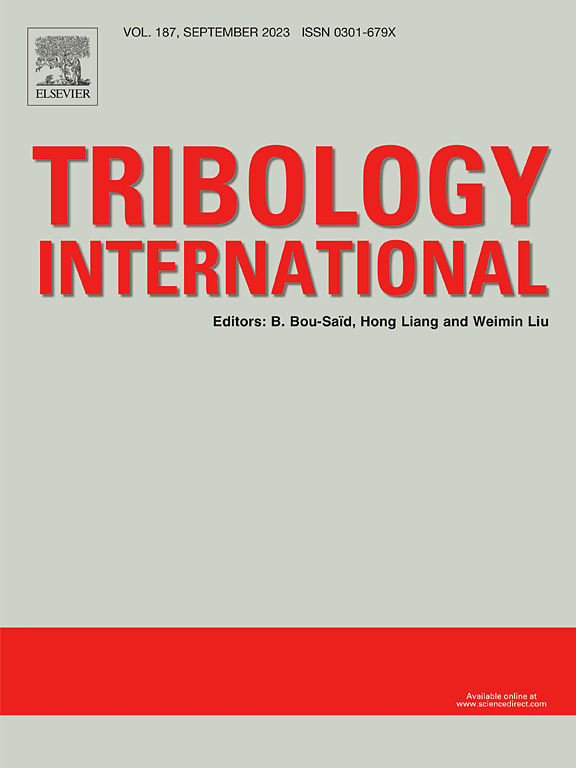IF 6.1
1区 工程技术
Q1 ENGINEERING, MECHANICAL
引用次数: 0
摘要
Ti-13Nb-13Zr(TNZ)合金具有完全的生物相容性,与标准钛生物材料相比杨氏模量值较低,因此在生物医学领域具有巨大的潜力。与市售的纯钛一样,TNZ 的硬度和机械强度也可以通过整体(冷轧)和表面(喷丸)机械处理得到提高。然而,这些工艺,尤其是它们的组合,如何影响 TNZ 在模拟体液中的摩擦学特性,目前仍是未知数。本研究针对这一问题,研究了微晶、冷轧、喷丸强化和冷轧+喷丸强化状态下 TNZ 的摩擦学性能。在 37°C 的汉克斯溶液中,通过针对板方法(使用 Al2O3 制成的针)测试了样品的磨损性能。除了摩擦学测试外,还使用显微镜和轮廓测量技术、显微硬度测试和电化学腐蚀分析进行了表面表征。冷轧+喷丸强化工艺的组合产生了最高的硬度(约 330 HV0.2 - 比初始状态高出近 100 个单位)和最低的磨料磨损,平均体积损失为 2.881 立方毫米,而未强化合金的平均体积损失为 3.521 立方毫米。腐蚀测试表明,表面处理(喷丸强化,可显著改善形貌)与耐腐蚀性之间存在相关性,因为对于磨削样品,无论是初始状态还是冷轧状态,被动电流密度都比喷丸强化合金低约 2.5-4 倍。尽管如此,所有样品在汉克斯溶液中都具有良好的腐蚀性能。研究结果表明,就 TNZ 三重腐蚀性能而言,冷轧和喷丸强化的组合是最有前途的。此外,这项研究还揭示了与汉克溶液中磨损过程相关的 TNZ 降解机制。本文章由计算机程序翻译,如有差异,请以英文原文为准。
Effect of bulk and surface mechanical treatments on the tribological properties of Ti-13Nb-13Zr alloy for biomedical applications
Ti-13Nb-13Zr (TNZ) alloy has great potential in the biomedical field due to its fully biocompatible composition and lower Young modulus value compared to the standard titanium biomaterials. As for the commercially pure Ti, the hardness and mechanical strength of TNZ can be enhanced by bulk (cold-rolling) and surface (shot-peening) mechanical treatments. However, it is still unknown how these processes, especially their combination, affect TNZ tribological properties in the simulated body fluids. This work responds to this aspect by investigating the tribological performance of TNZ in the microcrystalline, cold-rolled, shot-peened, and cold-rolled + shot-peened states. The wear behavior of the samples was tested by the pin-on-plate method (with a pin made of Al2O3) in the Hanks’ solution at 37°C. Tribological tests were supplemented with surface characterization using microscopy and profilometry techniques, microhardness tests and electrochemical corrosion analysis. The combination of the strengthening processes: cold rolling + shot peening resulted in the highest hardness (approx. 330 HV0.2 – almost 100 units more than for the initial state) and the lowest abrasive wear with an average volume loss of 2.881 mm3, while for the unstrengthened alloy, it amounted to 3.521 mm3. Corrosion tests revealed a correlation between surface treatment (shot peening, which significantly developed topography) and corrosion resistance, as for the grinded samples, passive current density was approx. 2.5–4 times lower than for the shot-peened alloy – for both: initial and cold-rolled states. Nevertheless, for all samples good corrosion properties in Hanks’ solution were received. The presented investigation revealed that the combination of cold rolling and shot-peening is the most promising in terms of TNZ tribo-corrosion performance. Moreover, this study shed light on TNZ degradation mechanisms, which are relevant during the wear process in Hank’s solution.
求助全文
通过发布文献求助,成功后即可免费获取论文全文。
去求助
来源期刊

Tribology International
工程技术-工程:机械
CiteScore
10.10
自引率
16.10%
发文量
627
审稿时长
35 days
期刊介绍:
Tribology is the science of rubbing surfaces and contributes to every facet of our everyday life, from live cell friction to engine lubrication and seismology. As such tribology is truly multidisciplinary and this extraordinary breadth of scientific interest is reflected in the scope of Tribology International.
Tribology International seeks to publish original research papers of the highest scientific quality to provide an archival resource for scientists from all backgrounds. Written contributions are invited reporting experimental and modelling studies both in established areas of tribology and emerging fields. Scientific topics include the physics or chemistry of tribo-surfaces, bio-tribology, surface engineering and materials, contact mechanics, nano-tribology, lubricants and hydrodynamic lubrication.
 求助内容:
求助内容: 应助结果提醒方式:
应助结果提醒方式:


